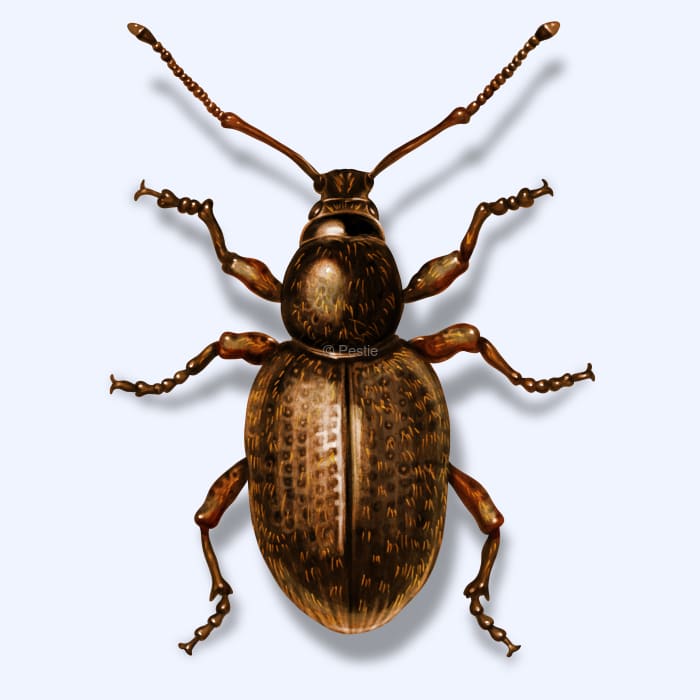How to identify and get rid of annual bluegrass weevils

Root out weevils: tips for a healthier lawn
Have you been noticing yellow or brown patches on your manicured lawn lately? Your watering is perfect, and you fertilize religiously. What could be the problem?
If your lawn is turfgrass, then you could be hosting annual bluegrass or Hyperodes weevils in your lawn. These beetles prefer a close-cut annual bluegrass lawn, and the larvae tunnel through the grass stems, leaving them hollow and often breaking at the crown. The adults chew on the grass leaves and will leave little notches in the leaves.
Golf courses and grass tennis courts are the most at risk of an annual bluegrass weevil infestation, but they can also become a problem for homeowners.
These weevils primarily target annual bluegrass but can also damage other cool-season grasses. The challenge with annual bluegrass weevils is not just their appetite for grass but also their stealthy nature. The damage is often attributed to other causes, such as disease or poor maintenance, before the true culprit is identified, leading to significant turf loss and costly restoration efforts.
How to identify annual bluegrass weevils
Annual bluegrass weevils are small beetles with a distinctive curved snout that sets them apart from other pests. Their bodies are usually dull brown to black and may feature lighter or mottled patterns. Their body may also be covered in yellowish hairs and scales that fall off the older the weevil gets.
They will have a more oval-shaped body, and if you have magnification, you can see their antennae are bent like an elbow and have a club at the end.
How big are annual bluegrass weevils?
They don't get any bigger than ¼ inch.
Where do annual bluegrass weevils live?
Annual bluegrass weevils are more common in the Northeastern United States, particularly on golf courses. However, reports of annual bluegrass weevil observations have been made in the Midwest and some Southwestern states.
How to get rid of annual bluegrass weevils
Getting weevils out of your yard can be challenging, but it is possible to prevent them from establishing.
First, you'll want to monitor for the weevil if you notice symptoms in the yard. Symptoms include:
- Yellow or brown patches
- Hollow stems with saw-dust frass
- Notched leaves
To monitor for the weevil, follow these steps:
- Create a soap flush with one fluid ounce of liquid soap detergent with one gallon of water
- Pour one pint of the solution on a 1 ft x 1 ft section of your lawn
- Pour another pint every five minutes
- Collect adults
If you notice 20-40 adults coming from your flushed area, you need to take action to start controlling the weevils.
Here are some ways you can start to control or reduce weevils in your yard:
- Remove grass clippings from your yard
- Provide adequate fertilizer
- Aerate and dethatch soil
- Avoid overwatering
Treat annual bluegrass weevils with Pestie
If you're still having trouble keeping annual bluegrass weevils away, the best option is to use a pro-grade, effective pest control solution like Pestie.
Pestie is a do-it-yourself pest control solution that's specially designed to keep annual bluegrass weevils and other pests away from your home.
With Pestie, you can rest easy knowing that your living space is protected and free of creepy crawlies. And the best part? It's designed for people, pets, and the planet, so you can say goodbye to harsh chemicals and hello to peace of mind!
- Save hundreds compared to traditional annual pest plans
- People, pet, and planet-friendly
- Pro-grade customized formulas
Quick facts
- Scientific name
Listronotus Maculicollis
- Other common names
Hyperodes Weevils
- Colors
Dull brown to black
- Life span
2-3 months
- Diet
Larvae feed on roots and stems, and adults feed on leaves
How dangerous are Annual Bluegrass Weevils?
Low danger risk
Annual bluegrass weevils aren't harmful to humans directly but can cause significant damage to lawns and ornamental plants, potentially leading to costly landscape repairs.
In optimal conditions, annual bluegrass weevils can complete their lifecycle in just a few weeks, allowing multiple generations to occur in one season.








